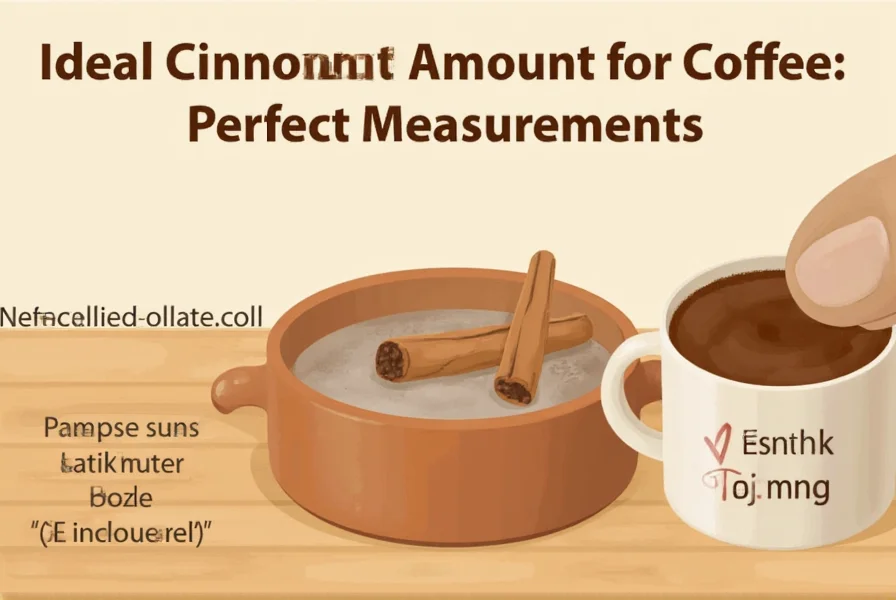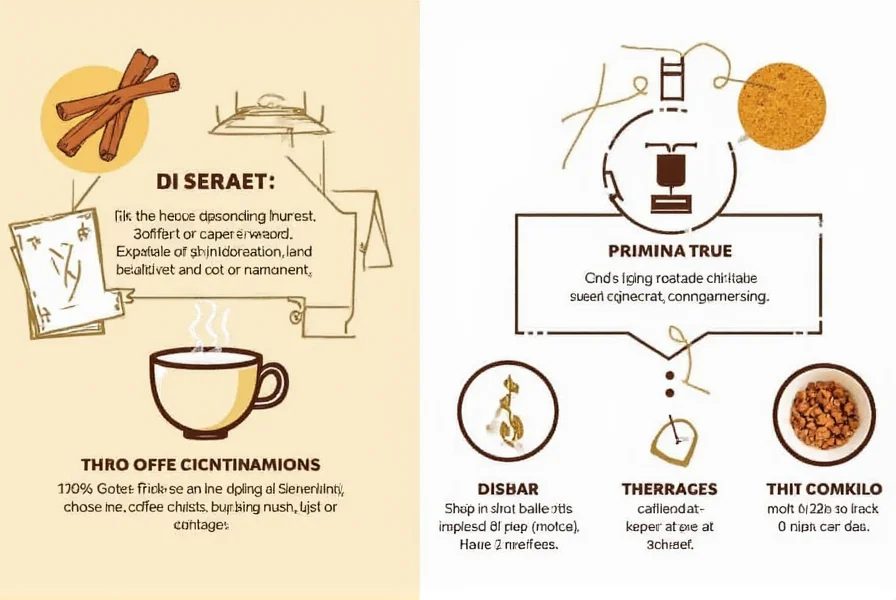Adding cinnamon to coffee creates a warm, aromatic experience that enhances both flavor and potential health benefits. Getting the measurement right ensures you enjoy the perfect balance between coffee's natural bitterness and cinnamon's sweet-spicy notes.
Understanding Cinnamon Measurements for Coffee
When determining how much cinnamon in coffee creates the ideal experience, several factors come into play. The standard recommendation of 1/8 to 1/4 teaspoon per standard 8-ounce cup serves as an excellent starting point for most coffee drinkers. This small amount delivers noticeable flavor without overwhelming your palate or creating unpleasant texture issues.
For those wondering how much cinnamon to add to coffee for optimal flavor, consider these practical measurements:
| Coffee Volume | Basic Cinnamon Measurement | For Stronger Flavor |
|---|---|---|
| 8 ounces (standard cup) | 1/8 teaspoon | 1/4 teaspoon |
| 12 ounces (larger mug) | 3/16 teaspoon | 1/3 teaspoon |
| 16 ounces (travel mug) | 1/4 teaspoon | 1/2 teaspoon |
Factors Affecting Your Cinnamon Coffee Ratio
The perfect cinnamon measurement for coffee depends on several variables beyond simple volume. Understanding these elements helps you customize your spiced coffee experience precisely to your preferences.
Coffee Type and Roast Level
Dark roast coffees with bold, smoky profiles can handle slightly more cinnamon (up to 1/4 teaspoon per cup) without losing their distinctive character. Lighter roasts with delicate floral or fruity notes work best with the smaller measurement (1/8 teaspoon) to avoid flavor masking. Espresso-based drinks require even less cinnamon due to their concentrated nature—start with just 1/16 teaspoon per shot.
Cinnamon Variety Matters
Not all cinnamon delivers the same intensity. Ceylon cinnamon (often called "true cinnamon") offers a more delicate, citrusy flavor that allows for slightly higher measurements. Cassia cinnamon, the more common variety found in supermarkets, has a stronger, more pungent profile requiring more careful measurement. When using cassia, stick to the lower end of the measurement range to prevent bitterness.

Best Methods for Adding Cinnamon to Coffee
How you incorporate cinnamon affects both flavor distribution and texture in your final cup. The most effective techniques for adding cinnamon to coffee properly include:
- Stirring method: Add ground cinnamon directly to your brewed coffee and stir thoroughly for even distribution
- Grounds integration: Mix cinnamon with coffee grounds before brewing for deeper flavor infusion
- Spice-infused milk: Heat milk with cinnamon before adding to coffee for creamy, aromatic results
- Cinnamon stick stirring: Use a small cinnamon stick as a stirrer for subtle flavor release
For those concerned about sediment at the bottom of their cup, the grounds integration method works best as the brewing process filters out most particles. The stirring method requires thorough mixing and works best with finely ground cinnamon.
Flavor Science: Why Cinnamon Complements Coffee
Understanding the ideal cinnamon quantity for coffee becomes easier when you recognize how these flavors interact. Cinnamon's natural sweetness counteracts coffee's bitterness without added sugar, while its warm spice notes enhance coffee's inherent chocolatey and nutty undertones. The compounds in cinnamon bind with coffee's aromatic molecules, creating new flavor compounds that neither ingredient possesses alone.
When experimenting with cinnamon coffee proportions, remember that our taste perception changes as coffee cools. What seems perfectly balanced when piping hot might taste weak at room temperature. For consistent flavor throughout your drinking experience, slightly increase the cinnamon when preparing iced coffee or beverages meant to be consumed cold.
Health Considerations for Cinnamon Coffee
While enjoying cinnamon-spiced coffee, be mindful of consumption limits. Cassia cinnamon contains coumarin, which in large amounts may affect liver function. The European Food Safety Authority recommends limiting daily coumarin intake to 0.1 mg per kilogram of body weight. For most adults, this means keeping daily cinnamon consumption below 1 teaspoon.
For regular coffee drinkers adding cinnamon to multiple daily cups, sticking to the lower measurement (1/8 teaspoon per cup) ensures you stay within safe limits while still enjoying flavor benefits. Those with cinnamon allergies or sensitivities should avoid this addition completely.
Common Cinnamon Coffee Mistakes to Avoid
Many coffee enthusiasts make these errors when determining how much cinnamon in coffee creates the best experience:
- Using too much cinnamon, resulting in overpowering spice and sediment
- Adding cinnamon to already sweetened coffee, creating unbalanced sweetness
- Using coarse cinnamon that doesn't dissolve properly
- Adding cinnamon to boiling coffee, which can create bitterness
- Not adjusting measurements for different coffee types and strengths

Creative Cinnamon Coffee Variations
Once you've mastered the basic cinnamon measurement for coffee, experiment with these sophisticated combinations:
- Cinnamon-vanilla blend: Combine 1/8 teaspoon cinnamon with 2-3 drops vanilla extract
- Spiced latte twist: Add 1/8 teaspoon cinnamon to your milk before steaming for lattes
- Golden milk coffee: Mix 1/8 teaspoon cinnamon with 1/16 teaspoon turmeric and black pepper
- Maple-cinnamon fusion: Replace sugar with 1/4 teaspoon pure maple syrup plus 1/8 teaspoon cinnamon
These combinations demonstrate how understanding cinnamon coffee proportions allows for endless customization while maintaining balanced flavor profiles. The key principle remains consistent: start with small measurements and adjust gradually based on your personal taste preferences.
Frequently Asked Questions
Can I use cinnamon sticks instead of ground cinnamon in coffee?
Yes, you can use cinnamon sticks as an alternative to ground cinnamon. Place a small 2-3 inch piece in your coffee mug and use it as a stirrer. This method releases flavor more gradually, creating a milder cinnamon presence. One cinnamon stick typically provides equivalent flavor to 1/8 teaspoon of ground cinnamon when stirred in hot coffee for 30-60 seconds.
Does adding cinnamon to coffee affect caffeine content?
No, adding cinnamon to coffee does not alter the caffeine content. Cinnamon is a flavoring agent that affects taste and aroma but doesn't interact with caffeine molecules. The caffeine level remains determined solely by your coffee beans and brewing method. However, cinnamon's natural energy-boosting properties may create a synergistic effect with caffeine, potentially enhancing your perceived energy levels.
How long does cinnamon stay dissolved in coffee?
Ground cinnamon begins settling after 2-3 minutes in still coffee. To maintain even distribution, stir your coffee every minute while drinking. Finely ground cinnamon stays suspended longer than coarsely ground varieties. For longer-lasting suspension, mix cinnamon with a small amount of hot water first to create a paste before adding to your coffee.
Can I add cinnamon to cold brew coffee?
Yes, you can add cinnamon to cold brew coffee, but the measurement differs from hot coffee. Cold brew requires slightly more cinnamon (about 3/16 teaspoon per 8 ounces) because cold temperatures reduce flavor perception. For best results, add cinnamon to the cold brew during the steeping process rather than after brewing, allowing for better flavor integration over the 12-24 hour brewing period.
Does cinnamon make coffee sweeter without sugar?
Cinnamon creates the perception of sweetness through its natural flavor compounds without adding actual sugar. The cinnamaldehyde in cinnamon activates sweet receptors on your tongue, making coffee taste sweeter while reducing perceived bitterness. This effect allows many people to reduce or eliminate added sugar in their coffee while still enjoying a sweet-tasting beverage.











 浙公网安备
33010002000092号
浙公网安备
33010002000092号 浙B2-20120091-4
浙B2-20120091-4